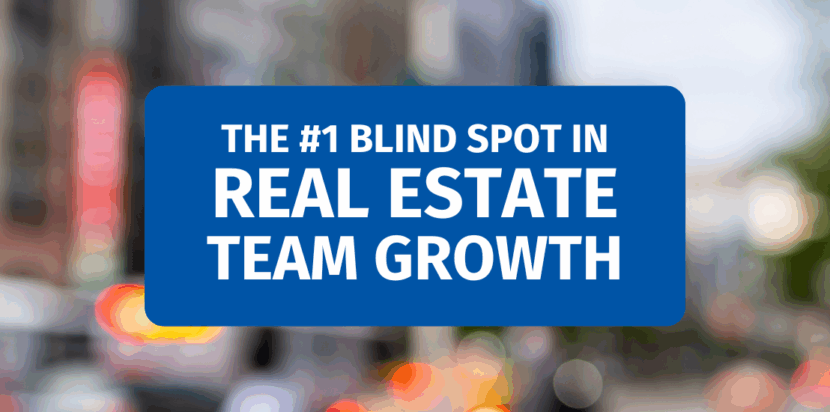The #1 Blind Spot in Real Estate Team Growth
- home
- The #1 Blind Spot in Real Estate Team Growth
The #1 Blind Spot in Real Estate Team Growth
- Home
- The #1 Blind Spot in Real Estate Team Growth
The #1 Blind Spot in Real Estate Team Growth
Table of Contents
The Reactive Growth Journey
There’s a common growth journey in the path of being a real estate team leader.
Often it looks a lot like this:
- Stage 1: You're a top producing agent yourself. You've worked very hard to build your personal business. Now, you can't find the time to serve all your clients.
- Stage 2: You Hire Agent Partners. You're maxed out on time but have the opportunities. So you decide to bring on agent partners. You're now responsible for THEIR success as well as your own.
- Stage 3: You scale lead generation. Now, with more "mouths to feed" you need to invest in generating leads. You start spending to build the business. But you quickly learn that more leads mean nothing unless they convert.
- Stage 4: You Invest in Tech Tools: You're spending on lead generation, which makes you even more aware of opportunities falling through the cracks. So you up your game and invest in new tech, CRM or tools.
- Stage 5: You add Support Staff: You're investing in leads. You're investing in new platforms. But you realize you can't do it all alone. You need to build a support team to help track, train, and support. Your overhead now includes wages and/or salary.
But every move was reactive. Patching one problem before moving on to the next.
And that’s how you end up with what’s called a “Ball of Band‑Aids” in the world of training and development.
Meet: The “Ball of Band-Aids” (and why it costs teams big)
…instead of a strategic system with scalable results.
It’s a collection of quick‑fixes and scattered solutions.
- 1. Disjointed Training Program: You have calls or training sessions to support agents. But there's no "one" system that ties it all together. This leads to lots of redundancy with wasted time and resources.
- 2. Reactive Problem‑Solving: You're reacting instead of proactively shaping results. You spend your time and energy putting out fires and answering "gotta-minutes" instead of designing your path forward.
- 3. One‑and‑Done Sessions: You have "weekly calls" or training sessions, but nothing ties it all together. If agents do attend training, there's no follow through on measuring their path into steady production.
- 4. Over‑Reliance on External Vendors: In hopes of adding support, you have multiple, scattered third‑party solutions. Again leading to redundancy, bleeding resources, and abdication of owning your own systems.
- 5. Tech Overload Without Strategy: You add new platforms aiming to solve problems. But end up with multiple platforms that aren't integrated. "Systems" become more about the tool itself rather than the problem it was meant to solve.
- 6. No Measurable Impact: You are investing time, resources and attention into fixing problems, but with no way to track how this impacts business performance. You still can't get your agents into production consistently and reliably in a shorter time frame.
- 7. Lack of Buy‑In: Because of the patchwork structure, the training and tools are an "extra" line in your offering, instead of a core business driver as a leader.

The term of a ‘Ball of Band-Aids” in training and development is used to describe a patchwork approach where solutions are reactive, fragmented, and built on quick-fixes.
Patchwork Systems Stifle Growth (and bleed time and profit)
- Quick-fix solutions lead to a business system made up of disconnected parts
- Each layer makes it more complicated, not better
- The deeper and further you go building this way, the riskier and more costly it gets
And at the end of the day: What doesn’t scale only becomes a liability, instead of an asset.
The First Steps to a Unified System
Step 1: Run the CLARITY Assessment
You can’t improve what you don’t measure. You need clarity. Before you blow it all up, answer these questions about your current agent systems:
👇Download the CLARITY Assessment Resource below:👇
Review the C.L.A.R.I.T.Y. areas in the checklist to find out where your system is costing you more than you realize.
Step 2: Identify Your Biggest Gap
Review your scores in the assessment and pick the lowest‑scoring area in the Clarity checklist. Now move with the snowball method. Start with the weakest link and make it your top priority for improvement.
Step 3: Set a Clear Target in That Category
Step 4: Build a Micro‑System
Step 5: Measure One Metric
Step 6: Test and Iterate
The Power of Building Your Own System
So that you can:
- Protect yourself from leadership changes: Your organization should not rely on having a "unicorn" in any seat.
- Create valuable intellectual property that you OWN: Gain agency over your own results. Lower costs and increase results over time instead of relying on third parties as a band-aid fix. Your team's success should not be built on rented land.
- Differentiate yourself in your market: Your ability to guide agents from day one to long-term success IS your offer. The sharper your system is, the more valuable you are as a team to partner with.
- Refine and get sharper over time: Build an asset that grows in value over time, instead of a growing liability.
- Prepare your organization for scale: A truly resilient organization is one empowered with agency over its own results.
Tag:
Table of Contents


Comments are closed